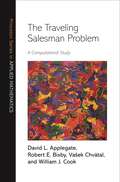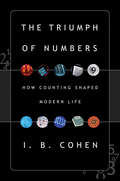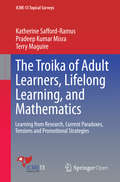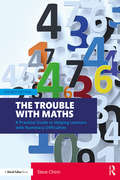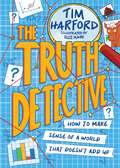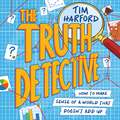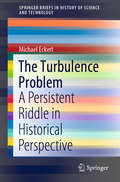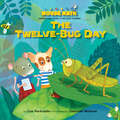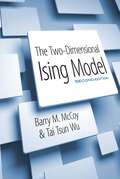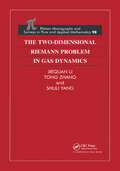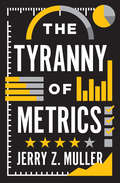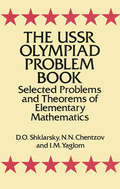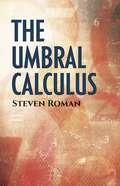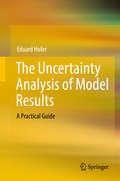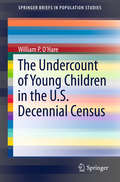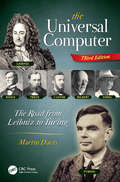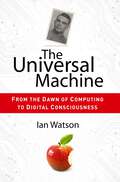- Table View
- List View
The Traveling Salesman Problem: A Computational Study (Princeton Series in Applied Mathematics #17)
by William J. Cook Robert E. Bixby David L. Applegate Vašek ChvátalThis book presents the latest findings on one of the most intensely investigated subjects in computational mathematics--the traveling salesman problem. It sounds simple enough: given a set of cities and the cost of travel between each pair of them, the problem challenges you to find the cheapest route by which to visit all the cities and return home to where you began. Though seemingly modest, this exercise has inspired studies by mathematicians, chemists, and physicists. Teachers use it in the classroom. It has practical applications in genetics, telecommunications, and neuroscience. The authors of this book are the same pioneers who for nearly two decades have led the investigation into the traveling salesman problem. They have derived solutions to almost eighty-six thousand cities, yet a general solution to the problem has yet to be discovered. Here they describe the method and computer code they used to solve a broad range of large-scale problems, and along the way they demonstrate the interplay of applied mathematics with increasingly powerful computing platforms. They also give the fascinating history of the problem--how it developed, and why it continues to intrigue us.
The Traveling Salesman Problem: Optimization with the Attractor-Based Search System (Synthesis Lectures on Operations Research and Applications)
by Weiqi LiThis book presents a new search paradigm for solving the Traveling Salesman Problem (TSP). The intrinsic difficulty of the TSP is associated with the combinatorial explosion of potential solutions in the solution space. The author introduces the idea of using the attractor concept in dynamical systems theory to reduce the search space for exhaustive search for the TSP. Numerous examples are used to describe how to use this new search algorithm to solve the TSP and its variants including: multi-objective TSP, dynamic TSP, and probabilistic TSP. This book is intended for readers in the field of optimization research and application.
The Triangle (Surprising Shapes)
by Patricia Smeltzer Victor SmeltzerA series of "fun" books to give young children a basic idea of shapes, sizes and colours.
The Triangle Secret: The Math Kids (Book 6) (The Math Kids)
by David ColeWhen FBI Special Agent Carlson is kidnapped while investigating the plane crash of Willard Howell, an eccentric billionaire inventor, the Math Kids spring into action. If Catherine, Stephanie, Justin, and Jordan can figure out the Great Triangle mentioned in Howell's will, they might just uncover who's behind the crash and Agent Carlson's kidnapping—if they don't get caught themselves! The Math Kids: The Triangle Secret is the sixth book in the Math Kids series.
The Triumph of Numbers: How Counting Shaped Modern Life
by I. Bernard CohenFrom the pyramids to mortality tables, Galileo to Florence Nightingale, a vibrant history of numbers and the birth of statistics. The great historian of science I. B. Cohen explores how numbers have come to assume a leading role in science, in the operations and structure of government, in marketing, and in many other aspects of daily life. Consulting and collecting numbers has been a feature of human affairs since antiquity--taxes, head counts for military service--but not until the Scientific Revolution in the twelfth century did social numbers such as births, deaths, and marriages begin to be analyzed. Cohen shines a new light on familiar figures such as Thomas Jefferson, Benjamin Franklin, and Charles Dickens; and he reveals Florence Nightingale to be a passionate statistician. Cohen has left us with an engaging and accessible history of numbers, an appreciation of the essential nature of statistics.
The Troika of Adult Learners, Lifelong Learning, and Mathematics
by Katherine Safford-Ramus Pradeep Kumar Misra Terry MaguireThis book presents a synopsis of six emerging themes in adult mathematics/numeracy and a critical discussion of recent developments in terms of policies, provisions, and the emerging challenges, paradoxes and tensions. It also offers an extensive review of the literature adult mathematics education. Why do adults want to learn mathematics? Did they enjoy mathematics at school so much that they want to continue? NO! Most of these adults have to learn mathematics because it is part of a formal qualification they need, because their job demands the ability to apply mathematics, or because they need basic numeracy in their daily lives. Lastly, the authors discuss five potential strategies to promote lifelong learning of mathematics among adult learners.
The Trouble with Maths: A Practical Guide to Helping Learners with Numeracy Difficulties
by Steve ChinnNow in its fourth edition, with updates to reflect developments in our understanding of learning difficulties in maths, this award-winning text provides vital, pragmatic insights into the often-confusing world of numeracy. By looking at learning difficulties in maths and dyscalculia from several perspectives, for example, the vocabulary and language of maths, cognitive style and the demands of individual procedures, this book provides a complete overview of the most frequently occurring problems associated with maths teaching and learning. Drawing on tried-and-tested methods based on research and Steve Chinn’s decades of classroom experience, it provides an authoritative yet accessible one-stop classroom resource. Combining advice, guidance and practical activities, this user-friendly guide will help you to: develop flexible cognitive styles use alternative strategies to replace an over-reliance on rote-learning for pupils trying to access basic facts understand the implications of underlying skills, such as working memory, on learning implement effective pre-emptive measures before demotivation sets in recognise the manifestations of maths anxiety and tackle affective domain problems find approaches to solve word problems select appropriate materials and visual images to enhance understanding. With useful features such as checklists for the evaluation of books and an overview of resources, this book will equip you with essential skills to help you tackle your pupils’ maths difficulties and improve standards for all learners. This book will be useful for all teachers, classroom assistants, learning support assistants and parents.
The Trouble with Maths: A practical guide to helping learners with numeracy difficulties
by Steve ChinnNow in third edition, with updates to reflect developments in our understanding of learning difficulties in maths, this award-winning text provides vital insights into the often confusing world of numeracy. By looking at learning difficulties in maths and dyscalculia from several perspectives, including the vocabulary and language of maths, thinking styles and the demands of individual procedures, this book provides a complete overview of the most frequently occurring problems associated with maths teaching and learning. Drawing on tried-and-tested methods based on research and Steve Chinn’s years of classroom experience, it provides an authoritative yet accessible one-stop classroom resource. Combining advice, guidance and practical activities, this user-friendly guide will help you to: develop flexible thinking styles use alternative strategies to replace an over-reliance on rote learning for pupils trying to access basic facts understand the implications of underlying skills, such as working memory, on learning implement effective pre-emptive measures before demotivation sets in recognise the manifestations of maths anxiety and tackle affective domain problems find approaches to solve word problems select appropriate materials and visual images to enhance understanding. With useful features such as checklists for the evaluation of books and a comprehensive overview of resources, this book will equip you with essential skills to help you tackle your pupils’ maths difficulties and improve standards. This book will be useful for all teachers, classroom assistants, learning support assistants and parents.
The Truth Detective: How to make sense of a world that doesn't add up
by Tim Harford'Tim Harford is peerless at making sense of a complicated world and our place within it. This is a book that all children should read' - Matthew Syed-> Did you know that a toy spaceship can teach you about inflation?-> Or that a pooping cow can show you how to invest your pocket money?-> And that even the greatest detectives have been fooled by fake news and dancing fairies?The world is often full of bamboozling headlines and numbers that don't add up. But don't panic. Within these pages you will transform into a Truth Detective, hunting down the truth about the world around you. You will meet heroic truth detectives, such as Florence Nightingale who started a revolution with a pie chart. You will encounter dastardly villains who have tried to trip us up with dodgy data and misinformation. And you will learn how being smart and savvy with numbers, will help you be smart and savvy about everything else in life too.So grab your detective cap, pick up your magnifying glass and start seeing the world like never before.A must read for curious kids from presenter of BBC Radio 4's "More or Less", Tim Harford and with wonderful illustrations to enjoy by Ollie Mann.
The Truth Detective: How to make sense of a world that doesn't add up
by Tim Harford'Tim Harford is peerless at making sense of a complicated world and our place within it. This is a book that all children should read' - Matthew Syed-> Did you know that a toy spaceship can teach you about inflation?-> Or that a pooping cow can show you how to invest your pocket money?-> And that even the greatest detectives have been fooled by fake news and dancing fairies?The world is often full of bamboozling headlines and numbers that don't add up. But don't panic. Within these pages you will transform into a Truth Detective, hunting down the truth about the world around you. You will meet heroic truth detectives, such as Florence Nightingale who started a revolution with a pie chart. You will encounter dastardly villains who have tried to trip us up with dodgy data and misinformation. And you will learn how being smart and savvy with numbers, will help you be smart and savvy about everything else in life too.So grab your detective cap, pick up your magnifying glass and start seeing the world like never before.A must read for curious kids from presenter of BBC Radio 4's "More or Less", Tim Harford and with wonderful illustrations to enjoy by Ollie Mann.
The Turbulence Problem: A Persistent Riddle in Historical Perspective (SpringerBriefs in History of Science and Technology)
by Michael EckertOn the road toward a history of turbulence, this book focuses on what the actors in this research field have identified as the “turbulence problem”. Turbulent flow rose to prominence as one of the most persistent challenges in science. At different times and in different social and disciplinary settings, the nature of this problem has changed in response to changing research agendas. This book does not seek to provide a comprehensive account, but instead an exemplary exposition on the environments in which problems become the subjects of research agendas, with particular emphasis on the first half of the 20th century.
The Twelve-Bug Day (Mouse Math)
by Lisa HarkraderEach read-aloud book in the Mouse Math series focuses on a single, basic math concept and features adorable mice, Albert and Wanda, who live in a People House. Entertaining fiction stories capture kids&’ imaginations as the mice learn about numbers, shapes, sizes, and more. Over 3 million copies sold worldwide!A dozen bugs? That&’s a lot! Still, Albert is sure he&’ll find all twelve on the class field trip to the insect zoo. After all he loves bugs. What he doesn&’t love? Subtraction. But if he counts down, bug by bug, he might just win lunch with the famous entomologist, Arizona Brown! Every Mouse Math title includes back matter activities that support and extend reading comprehension and math skills, plus free online activities. (Math Concept: Subtraction)
The Two-Dimensional Ising Model: Second Edition
by Barry M. Mccoy Prof. Tai Tsun Wu"Of all the systems in statistical mechanics on which exact calculations have been performed," declare the authors of this text, "the two-dimensional Ising model is not only the most thoroughly investigated; it is also the richest and most profound." Originally published in 1973, this is the definitive survey of the Ising model, a mathematical model of ferromagnetism in statistical mechanics. This updated edition of the classic text features an extensive section on new developments. Geared toward advanced undergraduates and graduate students of physics, it is also suitable for physicists working in statistical mechanics and related fields. Following a brief introductory chapter, the book explores statistical mechanics, the one-dimensional Ising model, dimer statistics, specific heat of Onsager's lattice in the absence of a magnetic field, boundary specific heat and magnetization, and boundary spin-spin correlation functions. Subsequent chapters cover the correlation functions, Wiener-Hopf sum equations, spontaneous magnetization, behavior of the correlation functions, asymptotic expansion, and boundary hysteresis and spin probability functions. Two other chapters examine Ising models with random impurities in terms of specific heat and boundary effects. The book concludes with a new chapter examining developments in the field since 1973.
The Two-Dimensional Riemann Problem in Gas Dynamics (Monographs And Surveys In Pure And Applied Mathematics Ser. #98)
by Tong Zhang Jiequan Li Shuli YangThe Riemann problem is the most fundamental problem in the entire field of non-linear hyperbolic conservation laws. Since first posed and solved in 1860, great progress has been achieved in the one-dimensional case. However, the two-dimensional case is substantially different. Although research interest in it has lasted more than a century, it has yielded almost no analytical demonstration. It remains a great challenge for mathematicians.This volume presents work on the two-dimensional Riemann problem carried out over the last 20 years by a Chinese group. The authors explore four models: scalar conservation laws, compressible Euler equations, zero-pressure gas dynamics, and pressure-gradient equations. They use the method of generalized characteristic analysis plus numerical experiments to demonstrate the elementary field interaction patterns of shocks, rarefaction waves, and slip lines. They also discover a most interesting feature for zero-pressure gas dynamics: a new kind of elementary wave appearing in the interaction of slip lines-a weighted Dirac delta shock of the density function. The Two-Dimensional Riemann Problem in Gas Dynamics establishes the rigorous mathematical theory of delta-shocks and Mach reflection-like patterns for zero-pressure gas dynamics, clarifies the boundaries of interaction of elementary waves, demonstrates the interesting spatial interaction of slip lines, and proposes a series of open problems. With applications ranging from engineering to astrophysics, and as the first book to examine the two-dimensional Riemann problem, this volume will prove fascinating to mathematicians and hold great interest for physicists and engineers.
The Tyranny of Metrics
by Jerry Z. MullerHow the obsession with quantifying human performance threatens our schools, medical care, businesses, and governmentToday, organizations of all kinds are ruled by the belief that the path to success is quantifying human performance, publicizing the results, and dividing up the rewards based on the numbers. But in our zeal to instill the evaluation process with scientific rigor, we've gone from measuring performance to fixating on measuring itself. The result is a tyranny of metrics that threatens the quality of our lives and most important institutions. In this timely and powerful book, Jerry Muller uncovers the damage our obsession with metrics is causing--and shows how we can begin to fix the problem.Filled with examples from education, medicine, business and finance, government, the police and military, and philanthropy and foreign aid, this brief and accessible book explains why the seemingly irresistible pressure to quantify performance distorts and distracts, whether by encouraging "gaming the stats" or "teaching to the test." That's because what can and does get measured is not always worth measuring, may not be what we really want to know, and may draw effort away from the things we care about. Along the way, we learn why paying for measured performance doesn't work, why surgical scorecards may increase deaths, and much more. But metrics can be good when used as a complement to—rather than a replacement for—judgment based on personal experience, and Muller also gives examples of when metrics have been beneficial.Complete with a checklist of when and how to use metrics, The Tyranny of Metricsis an essential corrective to a rarely questioned trend that increasingly affects us all.
The Tyranny of Metrics
by Jerry Z. MullerHow the obsession with quantifying human performance threatens business, medicine, education, government—and the quality of our livesToday, organizations of all kinds are ruled by the belief that the path to success is quantifying human performance, publicizing the results, and dividing up the rewards based on the numbers. But in our zeal to instill the evaluation process with scientific rigor, we've gone from measuring performance to fixating on measuring itself—and this tyranny of metrics now threatens the quality of our organizations and lives. In this brief, accessible, and powerful book, Jerry Muller uncovers the damage metrics are causing and shows how we can begin to fix the problem. Filled with examples from business, medicine, education, government, and other fields, the book explains why paying for measured performance doesn't work, why surgical scorecards may increase deaths, and much more. But Muller also shows that, when used as a complement to judgment based on personal experience, metrics can be beneficial, and he includes an invaluable checklist of when and how to use them. The result is an essential corrective to a harmful trend that increasingly affects us all.
The USSR Olympiad Problem Book: Selected Problems and Theorems of Elementary Mathematics (Dover Books on Mathematics)
by I. M. Yaglom D. O. Shklarsky N. N. ChentzovThis book contains 320 unconventional problems in algebra, arithmetic, elementary number theory, and trigonometry. Most of the problems first appeared in competitive examinations sponsored by the School Mathematical Society of the Moscow State University and the Mathematical Olympiads held in Moscow. Although most of the problems presuppose only high school mathematics, they are not easy; some are of uncommon difficulty and will challenge the ingenuity of any research mathematician. Nevertheless, many are well within the reach of motivated high school students and even advanced seventh and eighth graders.The problems are grouped into twelve separate sections. Among these are: the divisibility of integers, equations having integer solutions, evaluating sums and products, miscellaneous algebraic problems, the algebra of polynomials, complex numbers, problems of number theory, distinctive inequalities, difference sequences and sums, and more.Complete solutions to all problems are given; in many cases, alternate solutions are detailed from different points of view. Solutions to more advanced problems are given in considerable detail. Moreover, when advanced concepts are employed, they are discussed in the section preceding the problems. Useful in a variety of ways in high school and college curriculums, this challenging volume will be of particular interest to teachers dealing with gifted and advanced classes.
The Umbral Calculus
by Steven RomanGeared toward upper-level undergraduates and graduate students, this elementary introduction to classical umbral calculus requires only an acquaintance with the basic notions of algebra and a bit of applied mathematics (such as differential equations) to help put the theory in mathematical perspective. Subjects include Sheffer sequences and operators and their adjoints, with numerous examples of associated and other sequences. Related topics encompass the connection constants problem and duplication formulas, the Lagrange inversion formula, operational formulas, inverse relations, and binomial convolution. The final chapter offers a glimpse of the newer and less well-established forms of umbral calculus. 1984 edition.
The Umbral Calculus (Dover Books on Mathematics #Volume 111)
by Steven RomanGeared toward upper-level undergraduates and graduate students, this elementary introduction to classical umbral calculus requires only an acquaintance with the basic notions of algebra and a bit of applied mathematics (such as differential equations) to help put the theory in mathematical perspective.The text focuses on classical umbral calculus, which dates back to the 1850s and continues to receive the attention of modern mathematicians. Subjects include Sheffer sequences and operators and their adjoints, with numerous examples of associated and other sequences. Related topics encompass the connection constants problem and duplication formulas, the Lagrange inversion formula, operational formulas, inverse relations, and binomial convolution. The final chapter offers a glimpse of the newer and less well-established forms of umbral calculus.
The Unaffordable Price of Static Decision-making Models: Challenges in Economics and Management Science (International Series in Operations Research & Management Science #365)
by Fouad El Ouardighi Gustav FeichtingerAt the 15th Viennese Workshop on Optimal Control and Dynamic Games, held in July 2022, experts in economics and the management sciences identified a concerning trend: static decision-making models, while less effective than dynamic ones, are becoming increasingly prevalent. This book aims to address the economic and social costs associated with reliance on static models and to demonstrate the advantages of applying dynamic approaches. Static models may be easier to formulate, but they often overlook the long-term consequences of decisions, promoting myopic practices that can lead to poor outcomes. In contrast, dynamic models foster a more comprehensive perspective, enabling foresight in decision-making – which is crucial for issues involving stock variables, such as pollution, reputation, and inventory. The book explores the limitations of static models, including their inability to capture long-term outcomes, history-dependent solutions, and the impact of abrupt contextual changes. It also highlights recent advances in dynamic modeling techniques that can enhance accuracy and help adapt to complex decision-making environments. By promoting the shift from static to dynamic models, this book aspires to open new research opportunities and provide valuable insights for researchers, students, policymakers, and managers in the fields of economics and the management sciences.
The Uncertainty Analysis of Model Results: A Practical Guide
by Eduard HoferThis book is a practical guide to the uncertainty analysis of computer model applications. Used in many areas, such as engineering, ecology and economics, computer models are subject to various uncertainties at the level of model formulations, parameter values and input data. Naturally, it would be advantageous to know the combined effect of these uncertainties on the model results as well as whether the state of knowledge should be improved in order to reduce the uncertainty of the results most effectively. The book supports decision-makers, model developers and users in their argumentation for an uncertainty analysis and assists them in the interpretation of the analysis results.
The Undercount of Young Children in the U.S. Decennial Census
by William P. O'HareThis book covers several dimensions of the undercount of young children in the U. S. Decennial Census, examines the data from the 2010 U. S. Decennial Census in detail and looks at trends in the undercount of children over time. Other aspects included are the geographic distribution of the net undercount and an exploration for some of the potential explanations for the high net undercount of children. The number of young children in the US is growing, but almost one million young children (under age 5) were missed in the 2010 U. S. Decennial Census. The net undercount of young children has been higher than any other age group for the past several decades and is increasing rapidly, but little attention has been paid to the issue but demographers or the public.
The Unfinished Game: Pascal, Fermat, and the Seventeenth-Century Letter that Made the World Modern
by Keith DevlinIn the early seventeenth century, the outcome of something as simple as a dice roll was consigned to the realm of unknowable chance. Mathematicians largely agreed that it was impossible to predict the probability of an occurrence. Then, in 1654, Blaise Pascal wrote to Pierre de Fermat explaining that he had discovered how to calculate risk. The two collaborated to develop what is now known as probability theory?a concept that allows us to think rationally about decisions and events. In "The Unfinished Game," Keith Devlin masterfully chronicles Pascal and FermatOCOs mathematical breakthrough, connecting a centuries-old discovery with its remarkable impact on the modern world.
The Universal Computer: The Road from Leibniz to Turing, Third Edition
by Martin DavisThe breathtakingly rapid pace of change in computing makes it easy to overlook the pioneers who began it all. The Universal Computer: The Road from Leibniz to Turing explores the fascinating lives, ideas, and discoveries of seven remarkable mathematicians. It tells the stories of the unsung heroes of the computer age – the logicians.
The Universal Machine
by Ian WatsonThe computer unlike other inventions is universal; you can use a computer for many tasks: writing, composing music, designing buildings, creating movies, inhabiting virtual worlds, communicating... This popular science history isn't just about technology but introduces the pioneers: Babbage, Turing, Apple's Wozniak and Jobs, Bill Gates, Tim Berners-Lee, Mark Zuckerberg. This story is about people and the changes computers have caused. In the future ubiquitous computing, AI, quantum and molecular computing could even make us immortal. The computer has been a radical invention. In less than a single human life computers are transforming economies and societies like no human invention before.
